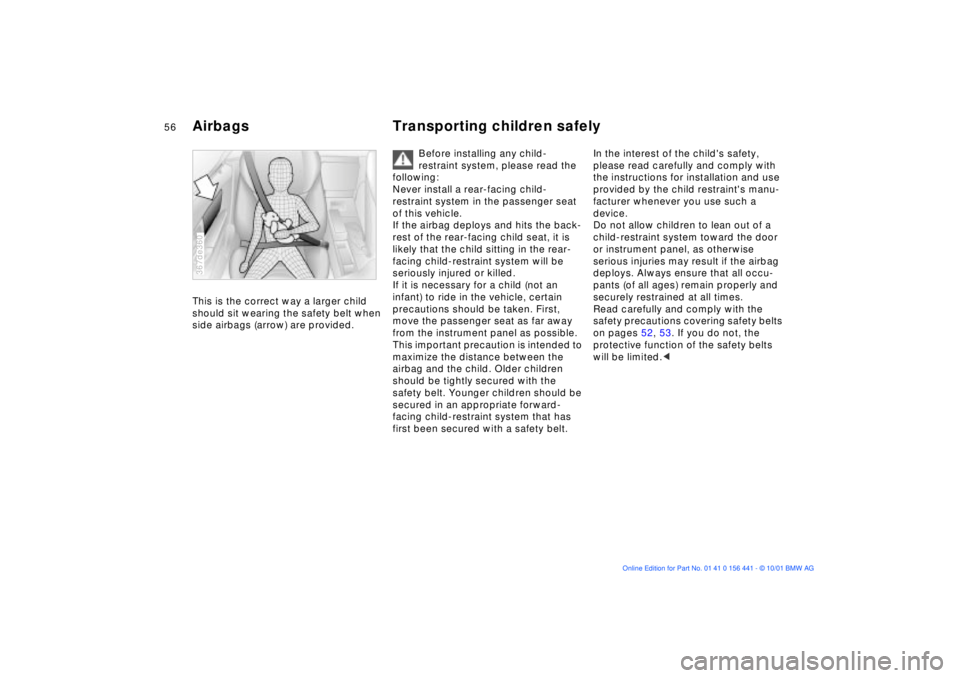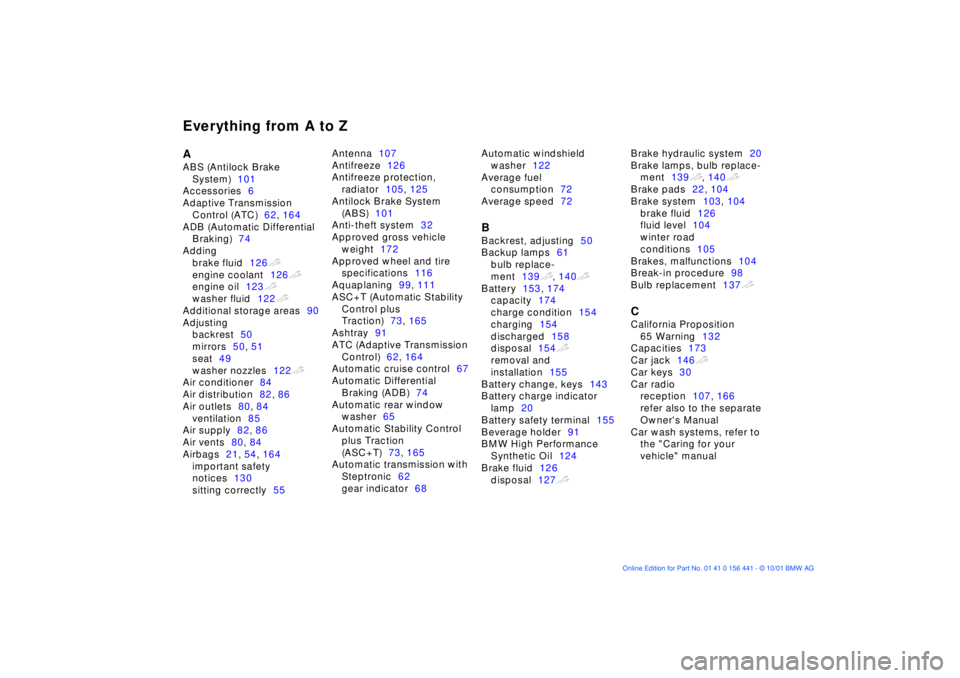2002 BMW Z3 airbag
[x] Cancel search: airbagPage 56 of 187

56n
Airbags Transporting children safely This is the correct way a larger child
should sit wearing the safety belt when
side airbags (arrow) are provided.367de360
Before installing any child-
restraint system, please read the
following:
Never install a rear-facing child-
restraint system in the passenger seat
of this vehicle.
If the airbag deploys and hits the back-
rest of the rear-facing child seat, it is
likely that the child sitting in the rear-
facing child-restraint system will be
seriously injured or killed.
If it is necessary for a child (not an
infant) to ride in the vehicle, certain
precautions should be taken. First,
move the passenger seat as far away
from the instrument panel as possible.
This important precaution is intended to
maximize the distance between the
airbag and the child. Older children
should be tightly secured with the
safety belt. Younger children should be
secured in an appropriate forward-
facing child-restraint system that has
first been secured with a safety belt.
In the interest of the child's safety,
please read carefully and comply with
the instructions for installation and use
provided by the child restraint's manu-
facturer whenever you use such a
device.
Do not allow children to lean out of a
child-restraint system toward the door
or instrument panel, as otherwise
serious injuries may result if the airbag
deploys. Always ensure that all occu-
pants (of all ages) remain properly and
securely restrained at all times.
Read carefully and comply with the
safety precautions covering safety belts
on pages 52, 53. If you do not, the
protective function of the safety belts
will be limited.<
Page 97 of 187

Overview
Controls and features
Operation, maintenance
Owner service procedures
Technical data
Index Advanced technology
97n
IndexDataTechnologyRepairsMaintenanceControlsOverview
Special operating instructions:
Break-in procedure98
Driving notes99
Catalytic converter100
Antilock Brake System
(ABS)101
Disc brakes103
Brake system104
Winter operation105
Power steering106
Cellular phone107
Car radio reception107
Hardtop Ð roadster108
Wheels and tires:
Notes on inflation pressures110
Tire condition110
Tire replacement111
Tire rotation113
Wheel and tire
combinations114
Special features of winter
tires115
Snow chains115
Approved wheel and tire
specifications116In the engine compartment:
Hood118
Engine compartment120
Fluids for the washer
systems122
Washer nozzles122
Engine oil123
Coolant125
Brake fluid126
Vehicle Identification127
Care and maintenance:
The BMW Maintenance
System128
Airbags130
Storing your vehicle130
Laws and regulations:
Technical modifications132
California Proposition
65 Warning132
OBD interface socket133
Maintenance
Page 130 of 187

130n
Airbags Storing your vehicle1 Front airbags on the driver and
passenger side
2 Side airbags on the driver and
passenger sideImportant safety notices
Do not attempt to remove the gas
generators of the airbag restraint
system from the vehicle or to disas-
semble them.
Have inspection and service proce-
dures performed by specially-trained
personnel only.
If the airbag restraint system malfunc-
tions, is deactivated or triggered as a
response to an accident, have the
system repaired by a BMW center only.
367de730
Do not make modifications of any kind
to the individual components or system
wiring. These include the upholstered
covers on the steering wheel hub, in the
instrument panel and in the side trim
panels of the doors. Never apply adhe-
sive materials to these components or
cover or modify them in any way. Do
not attempt to disassemble the steering
wheel itself.
To ensure compliance with applicable
safety regulations, have the airbag
generators disposed of by a BMW
center only.
Unprofessional attempts to service the
system could lead to failure in an emer-
gency or undesired airbag activation,
either of which could result in personal
injury.< If you intend to store the vehicle
for longer than three months, have
the maintenance operations described
on this page performed.<
Preparation for storageHave the following operations
performed by your BMW center:
1. Clean and apply a rust-proofing
agent or other treatment to the
engine, engine compartment, under-
carriage, axles and major compo-
nents in accordance with approved
repair procedures. Wash the vehicle,
clean the interior and treat painted
and chromed parts. Clean the rubber
seals around the hood, luggage
compartment and doors
2. Change the engine oil and oil filter
with the engine at operating temper-
ature. As an additional corrosion
protection measure, an anticorrosive
agent can be added to the engine in
accordance with the manufacturer's
instructions
3. Check the coolant level and concen-
tration and top up if necessary
4. Check the fluid level of the wind-
shield washer fluid reservoir; top up if
necessary
Page 163 of 187

Overview
Controls and features
Operation, maintenance
Owner service procedures
Technical data
Index Advanced technology
163n
IndexDataTechnologyRepairsMaintenanceControlsOverview
Adaptive Transmission Control
(ATC)164
Airbags164
Automatic Stability Control plus
Traction (ASC+T)/Dynamic
Stability Control (DSC)165
Car radio reception166
Safety belt tensioner166
Technology
Page 164 of 187

164n
For vehicles with automatic transmis-
sion, Adaptive Transmission Control
(ATC) performs the optimum gear selec-
tion based on a number of factors. This
system reacts to your individual driving
style and the current driving conditions.
The ATC recognizes your individual
driving style from the positions and
movements of the accelerator pedal,
delays during braking, and the vehicle's
lateral acceleration when cornering.
ATC makes the appropriate selection
from different shift characteristics
which range from comfort-oriented to
performance-oriented.
367us358
In order to take driving conditions into
account, ATC registers corners and
both uphill and downhill gradients. For
example, if you maintain speed through
a curve, the transmission does not
upshift.
On uphill gradients, it shifts only when
the engine speed increases in order to
make more efficient use of power
reserves. On downhill gradients ATC
downshifts when the speed of the vehi-
cles increases causing the driver to
step on the brakes.
Deceleration sensors continuously
monitor the physical forces acting upon
the vehicle. In the event of a severe
frontal impact, the gas generators of
the driver and passenger-side front
airbags are ignited simultaneously.
However, the passenger-side airbag is
only triggered if an additional sensor
has recognized that the passenger seat
is occupied.
If it is necessary during a side impact, a
side airbag will be triggered on the side
where the collision occurs.
390de012
ATC
*
Airbags
Page 165 of 187

165n
IndexDataTechnologyRepairsMaintenanceControlsOverview
The airbags located under the marked
covers inflate and unfold in a matter of
a few milliseconds. In this process they
tear through the designed breaking
points of the upholstered covers or
press them out.
Because the inflation process must be
virtually instantaneous, it is necessarily
accompanied by a certain amount of
ignition and inflation noise. The gas
required to inflate the airbags is not
dangerous, and it dissipates together
with the associated smoke.
The entire process is completed within
fractions of a second.Precision sensors monitor the number of
revolutions of the wheels. When
equipped with DSC, they also monitor
steering angle, lateral acceleration,
brake pressure and the movement of the
vehicle around its vertical axis.
If differences in the wheel speeds occur,
ASC+T recognizes the danger of wheel-
spin and reduces the drive torque. If
necessary, the system also responds
with additional applications of the brakes
at the rear wheels.
In addition, DSC permanently monitors
the vehicle's current operating condition
and compares it with an ideal condition
that is calculated from the sensor's
signals. If deviations from this occur
(understeering or oversteering, for
instance), DSC can stabilize the vehicle
in fractions of a second by adjusting
engine output and with the assistance of
braking intervention at individual wheels.
Within physically possible limits
dangerous skids can be prevented even
as they are just beginning.You may need some time to become
accustomed to this system's interven-
tion. However, it provides optimum
propulsive force and driving stability.
The braking intervention may be accom-
panied by a certain degree of noise.Airbags ASC+T/DSC
*
Page 178 of 187

Everything from A to ZAABS (Antilock Brake
System)101
Accessories6
Adaptive Transmission
Control (ATC)62, 164
ADB (Automatic Differential
Braking)74
Adding
brake fluid126t
engine coolant126t
engine oil123t
washer fluid122t
Additional storage areas90
Adjusting
backrest50
mirrors50, 51
seat49
washer nozzles122t
Air conditioner84
Air distribution82, 86
Air outlets80, 84
ventilation85
Air supply82, 86
Air vents80, 84
Airbags21, 54, 164
important safety
notices130
sitting correctly55Antenna107
Antifreeze126
Antifreeze protection,
radiator105, 125
Antilock Brake System
(ABS)101
Anti-theft system32
Approved gross vehicle
weight172
Approved wheel and tire
specifications116
Aquaplaning99, 111
ASC+T (Automatic Stability
Control plus
Traction)73, 165
Ashtray91
ATC (Adaptive Transmission
Control)62, 164
Automatic cruise control67
Automatic Differential
Braking (ADB)74
Automatic rear window
washer65
Automatic Stability Control
plus Traction
(ASC+T)73, 165
Automatic transmission with
Steptronic62
gear indicator68Automatic windshield
washer122
Average fuel
consumption72
Average speed72
BBackrest, adjusting50
Backup lamps61
bulb replace-
ment139t, 140t
Battery153, 174
capacity174
charge condition154
charging154
discharged158
disposal154t
removal and
installation155
Battery change, keys143
Battery charge indicator
lamp20
Battery safety terminal155
Beverage holder91
BMW High Performance
Synthetic Oil124
Brake fluid126
disposal127tBrake hydraulic system20
Brake lamps, bulb replace-
ment139t, 140t
Brake pads22, 104
Brake system103, 104
brake fluid126
fluid level104
winter road
conditions105
Brakes, malfunctions104
Break-in procedure98
Bulb replacement137t
CCalifornia Proposition
65 Warning132
Capacities173
Car jack146t
Car keys30
Car radio
reception107, 166
refer also to the separate
Owner's Manual
Car wash systems, refer to
the "Caring for your
vehicle" manual
From A to Z
Page 180 of 187

Everything from A to ZDSC (Dynamic Stability
Control)74, 165
Dynamic Brake Control
(DBC)103
Dynamic Stability Control
(DSC)74, 165EElectric convertible top
operation44
Electric power windows38
Electrical malfunction
convertible top157t
doors32t
fuel filler door157t
luggage compartment
lid37t
power convertible
top157t
Electrical system174
Electronic immobilizer31
Emergency release of
luggage compartment lid
from luggage
compartment's interior38
Engine
compartment120, 121Engine coolant126
adding126t
Engine oil123
adding123t
dipstick123
disposal125t
grades124
level21, 123t
pressure20
viscosity124
Engine output170
Engine specifications170
Exterior mirrors50
FFailure of an electrical
accessory156t
Fan82, 86
Filler cap cover25
Filling the washer
reservoir122t
First-aid kit24
Fittings, tow-starting and
towing159t
Flasher, headlamp64Flat tire111
Z3 roadster,
Z3 coupe146t
Folding top40
Footbrake103
Front airbags54, 130
Front fog lamps76
bulb replacement139t
Frost protection,
radiator105
Fuel26
Fuel consumption,
average72
Fuel filler door
electrical
malfunction157t
manual operation157t
Fuel gauge68
Fuel specifications26
Fuel tank capacity173
Fuses156
GGasoline26
Gear indicator68
Glass sunroof39
Glove compartment90
Grilles80, 84
Gross vehicle weight172HHardtop108
Hazard warning
flashers24t
Hazard warning system24
Hazard warning
triangle24t
Head restraints50
Headlamp cleaning
system122
Headlamp cover,
care137t
Headlamp flasher64
Headlamp washers66
Headlamps, high
beam23, 64
bulb replacement137t
Headlamps, low beam76
bulb replacement137t